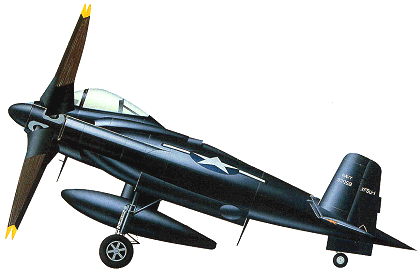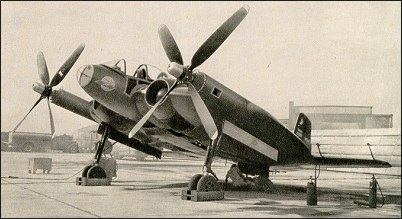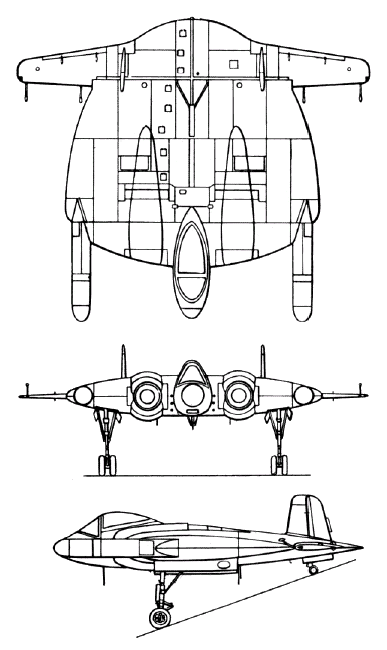|
| Almost certainly the most unusual aircraft designed by the company, the Chance Vought XF5U-1 was intended to produce a fighter aircraft which, in a fully-developed form, would have a speed range from 32 to 740km/h. It had a wing of almost circular planform, which also comprised the primary structure of the aircraft. Control surfaces were confined to the rear of the wing, consisting of twin fins and rudders, with a swept tailplane on each side. These latter surfaces each had an elevator which could be used collectively for control in pitch or differentially for roll control. Landing gear was of retractable tailwheel type. Power was provided by two Pratt & Whitney radial engines buried in the wing, one on each side for the fuselage and driving, via right-angle gearboxes, specially developed propellers, one at the forward extremity of each wing. Clutches and shafting were provided to ensure that, in emergency, both propellers could be driven by one engine.
To flight-test the concept a low-powered full-scale version was built as the V-173. Of wood and fabric construction, low-powered engines and fixed landing gear, this flew for the first time on 23 November 1942. Although the prototype XF5U-1 was completed and prepared for testing at Muroc Dry Lake (since renamed Edwards AFB), this aircraft was never flown.

| CREW | 1 |
| ENGINE | 2 x Pratt-Whitney R-2000-7, 825kW |
| WEIGHTS |
| Take-off weight | 7491 kg | 16515 lb |
| DIMENSIONS |
| Wingspan | 7.1 m | 23 ft 4 in |
| Length | 8.7 m | 29 ft 7 in |
| Height | 5.1 m | 17 ft 9 in |
| Wing area | 44.1 m2 | 474.69 sq ft |
| PERFORMANCE |
| Max. speed | 740 km/h | 460 mph |
| Range | 1600 km | 994 miles |
| ARMAMENT | 6 x 20mm machine-guns, 2 x 450kg bombs |
| todd, e-mail, 18.01.2014 07:03 To bad bother thr vf-173 and this one were destroyed after the war. Should have used for further testing in the STOL programs. Did however read that a repleca of the VF-173 was being built and would be test flown again. Cool looking aircraft this is and would have been intersting to see in person rather than just in pictures. reply | | Steve, e-mail, 12.12.2013 18:52 A STOL concept that could stand to be resurrected using propfans! reply | | Klaatu83, e-mail, 22.05.2013 22:59 Charles H. Zimmerman, who designed this aircraft, was among the NACA aeronautical engineers who examined a similar aircraft in 1934, designed by Dr. Cloyd L. Snyder called the Arup S-2. The Arup S-2 is listed on this website, and makes an interesting comparison with this aircraft. Created by a podiatrist, Dr, Snyder's aircraft was little more than a home-built, was produced on a shoe-string budget, and received little publicity or financial backing. Zimmerman, who subsequently went to work for a large aircraft manufacturing corporation (Vought), received considerable financial support, both from the company and from the Navy, to develop his aircraft. reply | | Shane, e-mail, 14.08.2011 06:35 STU Sammis if you look at the picture shown at the top both props spin clockwise as viewed from the cockpit. the planes wing shape and the location of the props actually led to the tip vorticies being almost non existant. reply | |
| | Klaatu, e-mail, 11.05.2011 05:02 "At 17 feet height, how did the pilot get into and out of the plane? Did they climb up the wing or did they use a ladder?"
If you study the top view drawing (above), you will note the reinforced steps built into the upper surface leading from the tail to the cockpit.
This was a revolutionary design for a STOL fighter suitable for operation from aircraft carriers. Unfortunately, it took so long to sort out all the development problems that, by the time it was finally ready to be test flown, World War II was over and the "Jet Age" had arrived, rendering the F5U already obsolete. In any case, by that time Vought had moved on to the development of the far-more-potent F7U :Cutlass". reply | | Bob Tufo, e-mail, 13.03.2011 19:43 Sorry about the typo, I mean't the Horton Bros, reply | | Bob Tufo, e-mail, 13.03.2011 19:41 Reminds me of the Hoton Bros. design . reply | | CraigL, e-mail, 16.12.2010 03:28 At 17 feet height, how did the pilot get into and out of the plane? Did they climb up the wing or did they use a ladder? reply | | STU Sammis, e-mail, 12.08.2010 21:23 My cousin worked on the gearbox arrangement which was a big challenge. The picture is unclear, but I'm sure the props were opposite rotation, and I think were designed to cancel or augment the wingtip vortesies, which provided remarkable benefits. Regretably, the US Navy, which funded this plane, ordered that it be scrapped when the program was abandoned, thus there is no remaining example. reply | | Knigonosha, e-mail, 13.02.2010 01:55 MAXIMUM SPEED: 388 mph at 20,000 feet. reply | | Mike, e-mail, 10.04.2009 17:34 what height is the ruder? reply |
|
Do you have any comments?
|
| 
COMPANY
PROFILE
All the World's Rotorcraft
|








